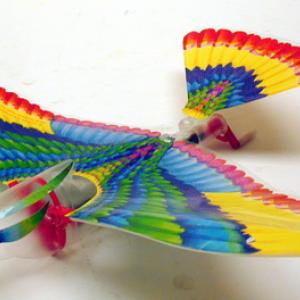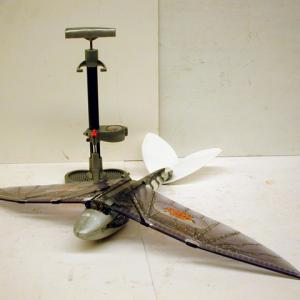College of Liberal Arts & Sciences
10C10.10 - Ornithopter
Wind the rubber band of the Ornithopter up to 50 turns. Then press the lever on the side of the Ornithopter body to start the wings in motion and launch the bird. If the tail is positioned correctly is should go up and circle and come back to you.
To fly the Air Hog Model in Lecture Room 1, 40 pumps of the air pump should be sufficient.
- Michael D. Mihail, Thomas F. George, and Bernard J. Feldman, "The Physics of Bird Flight: An Experiment", TPT, Vol. 46, # 3, March 2008, p. 155.
- Bernard J. Feldman, Thomas F. George, Charles A. Long, Claudine F. Long, Guoping Zhang, "Origin of Bird Flight: A Physics Viewpoint", TPT, Vol. 44, # 6, p. 351, Sept. 2006.
- Jennifer Sieben, "Birdlike Robot Flies Steady Without a Vertical Tail", Physics Today, Vol. 78, #3, March 2025, p. 15.
- Stephen G. Benka, "Morphing Wings Help Birds Control Gliding", Physics Today, June 2007, p. 28
- George M. Hopkins, "Gases", Experimental Science, p. 111.
- Rebecca Boyle, "The Quest for Human-Powered Flight", Popular Science, Oct. 2012, p. 63.
- H. Richard Crane, "A Plywood Goose That Seems To Fly", How Thing Work ( 1983 - 1995 ), p. 39.
- Julie Beck, "Flapper Fashion", "Mega Pixels: The Must-See Photos of the Month", Popular Science, p.14-15, Jan 2011.
- Ed Sobey, Woody Sobey, "Air Hog", The Way Toys Work, p. 4.
Disclaimer: These demonstrations are provided only for illustrative use by persons affiliated with The University of Iowa and only under the direction of a trained instructor or physicist. The University of Iowa is not responsible for demonstrations performed by those using their own equipment or who choose to use this reference material for their own purpose. The demonstrations included here are within the public domain and can be found in materials contained in libraries, bookstores, and through electronic sources. Performing all or any portion of any of these demonstrations, with or without revisions not depicted here entails inherent risks. These risks include, without limitation, bodily injury (and possibly death), including risks to health that may be temporary or permanent and that may exacerbate a pre-existing medical condition; and property loss or damage. Anyone performing any part of these demonstrations, even with revisions, knowingly and voluntarily assumes all risks associated with them.

